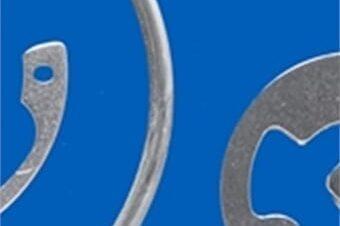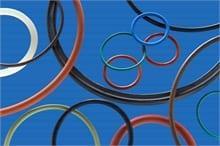

LSR (liquid silicone rubber) O-rings are growing in use in a variety of high-volume production applications, especially in life sciences.
O-rings are the most commonly used seal, featured in applications from aircraft engines to chemical processing lines, the hydraulics in tractors to subsea down-hole tools. They account for a significant amount of the global market for gaskets and seals, which according to Global Industry Analysts* will reach 45.8 billion USD by 2020.
Liquid-silicone rubber allows delicate parts to be formed reliably each time and can be produced down to 0.004 in. thick or less.
Specifiers and users prefer O-rings because their round profile allows for almost universal use in either axial or radial sealing arrangements, under static as well as moderately dynamic load conditions. Their basic geometry lends itself to relatively straightforward manufacture in either an injection molding or compression molding process in a number of materials.
The O-ring’s simple form, however, belies the materials and production technology behind this modest circle of rubber. To ensure long-life and integrity, the O-ring must be perfectly matched to system requirements. This may involve withstanding extreme temperatures, high pressures and aggressive contact media. They may also need to provide low-friction properties for automated assembly and in dynamic environments.
“Specifying the optimum O-ring for an application needs a precise understanding of system requirements along with specific and proven knowledge of material properties, Working with an O-ring supplier that has expertise in these areas and that can give test results for their materials is vital in ensuring the performance of equipment or manufacturing processes.
Life sciences spur growth
Experience with LSR is particularly important in some of the more demanding fields, such as life sciences. Global Industry Analysts stated that complex applications in some sectors, including the medical sector, will throw up manufacturing and design challenges.†
“We have seen this trend and one of the ways we have responded is by redefining precision when it comes to production of the simple O-ring; taking it to new levels for the most difficult of applications, especially in medical devices,” said Nollenberger.
As with any O-ring application, one must consider the expected function of the product, mating components, assembly considerations, operating conditions and expected service life to name a few. However, in life sciences, unwanted bacterial growth due to dead space in medical devices that cannot be reached by the typical means of sterilization can present huge problems.
“The challenge and the opportunity for a designer and manufacturer of an LSR part, whether O-ring or other geometry, is to not just supply a standard O-ring, but develop a solution with the client, which might still be an O-ring when we look at its basic shape and section, but is really a custom engineered solution in the end.Here, depending on application, the focus beyond the choice of material will then also be on aspects of the surface finish of our O-ring versus mating components, surface friction behavior and surface energy. More and more we are seeing a trend toward a fully integrated solution away from the concept of using simply an O-ring, but more so for us to supply a two-component solution that gives the absolute guarantee that there is no dead space by design or from possible inconsistent placement of an O-ring inside an assembly.”
How it works
To meet these challenges, Trelleborg Sealing Solutions now has four sites that specialize in LSR injection molding for users in the medical, automotive and various industrial fields. LSR is seeing an increase in demand in high-volume applications, particularly where complex part geometries and high consistent precision are needed, And advantage of LSR is that it is an extremely pure material, making it well suited for life sciences.
According to Jarno Burkhardt, general manager of the Stein am Rhein, Switzerland, facility, “Conventional elastomer O-ring production is either by injection or compression molding and typically requires deflashing either mechanically, by cutting or punching, or through a cryogenic process. These secondary process steps introduce process variability and manufacturing risks, along with extra direct as well as potentially indirect costs.
“In the LSR liquid injection molding process for O-rings, parts are molded without flash, with sprue or overflow easily separable from the functional component, so no secondary finishing operations are required,” concluded Burkhardt.
Most O-rings are manufactured from NBR (nitrile butadiene rubber) and EPDM (ethylene propylene diene methylene). However, the biggest advantage of LSR is that due to the low viscosity of the raw material, it can be injection molded into much more complex shapes than these materials—and much more easily than with any other elastomer.
Key benefits
The key advantages of injection molding LSR O-rings in a flash-less, waste-less tool design concept are:
• reduction of waste material
• no need for secondary process steps to remove flash and waste
• eliminates all quality risks that can be associated with secondary processes as well as related process and inspection costs
• continuously high dimensional stability and precision of the O-ring straight out of the mold
• full traceability of product not just by batch but also by cavity
In addition, LSR covers a broad temperature spectrum from –40 to 250° C (–40 to 480° F) and offers good chemical resistance to a range of fluids and chemicals. As with any elastomer, it has limited pressure capabilities, but this is principally down to the specific design and application conditions, said Nollenberger.
High-volume production
Critical to LSR production is that the raw material demands the use of high-end tooling as compared to more conventional rubber molding.Therefore, the tooling is more expensive. However, because of these high-end designs, the LSR tooling lasts longer and is typically guaranteed to last one million shots.
This is why high-volume production is required for LSR, as it is not worth the tooling changes for small batches.
Trelleborg Sealing Solutions has used this process for a micro-component just 1.4 x 1.1 mm that is produced in millions of pieces annually for a medical device. These parts are manufactured by directly injecting LSR material into each cavity of a multi-cavity tool. The O-rings are then removed from the cavities by a specially designed robotic gripper arm. As the parts are too small to engrave, for traceability, the O-rings are loaded into containers by cavity.
The development of the process to produce tiny O-rings has many challenges. One of these was to develop a robotic gripper arm that could handle parts weighing less than 0.0093 g each; a component so small and light that no human hand could handle it easily.

Flashless production is possible using Trelleborg’s needlepoint injection technology.
Another challenge was the electronic charge of the minute O-rings. This caused them to fly all over the place when released from the gripper.Their feather-like weight made it impossible to get them placed in designated containers post-production. To resolve this, engineers developed a so-called “Ionicator” that unloads the parts on their way from the mold into the container.
Implementing this process reduced material consumption by over 30%, plus zero defect quality levels are achieved straight out of production. These micro O-rings are currently produced on tools with up to 32-cavity.
“The next goal for the LSR technical team is to double the number of cavities to 64, not just for O-rings, but for other custom micro parts for innovative medical devices,” said Burkhardt.
The future of LSR
LSR technology is seeing extensive growth, with high-tech life sciences applications leading the way—for self-medication of chronic conditions such as autoimmune disorders, blood conditions and hormone deficiencies. Similarly, where health and safety scrutiny is high—such as in food processing and potable water— LSR can see future use.
In automotive, as more electronic features are incorporated, the demand for super-clean and integrated LSR components also grows.
“In addition, the rising demand for LSR is also related to urbanization, demographic and social changes as a growing, affluent population has greater buying power for electronics and other lifestyle products and consumables,At Trelleborg, it means that they will continue to push forward with tools, processes and automation technologies to let two things happen first, produce ever smaller parts, down to micro and soon nano-gram weights, and second, produce ever more complex two- and more component parts with LSR as one of the components.”
Have our catalogue sent to your door

